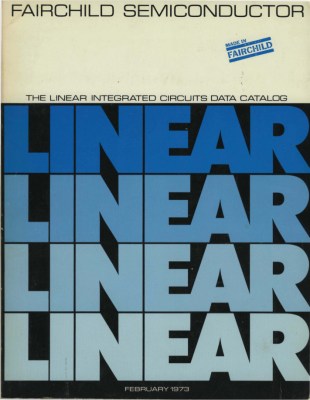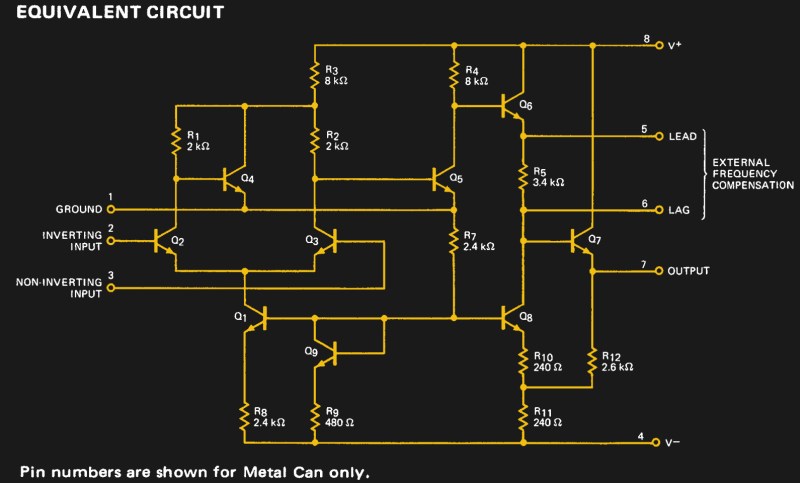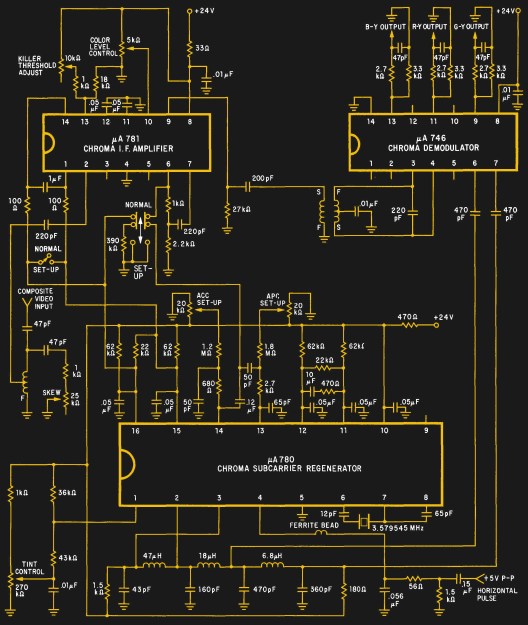As part of writing tech stories such as those we feature here at Hackaday, there is a huge amount of research to be done. We trawl through pages and pages of obscure blogs, videos, and data sheets. Sometimes we turn up resources interesting enough that we file them away, convinced that they contain the nucleus of another story at some point in the future.
 Today’s topic of entertainment is just such a resource, courtesy of the Internet Archive. It’s not a video as we’d often provide you in a Retrotechtacular piece, instead it’s the February 1973 edition of the Fairchild Semiconductor Linear Integrated Circuits Catalog. Books like this one that could be had from company sales representatives were highly prized in the days before universal Internet access to data sheets, and the ink-on-paper datasheets within it provide a fascinating snapshot of the integrated electronics industry as it was 45 years ago.
Today’s topic of entertainment is just such a resource, courtesy of the Internet Archive. It’s not a video as we’d often provide you in a Retrotechtacular piece, instead it’s the February 1973 edition of the Fairchild Semiconductor Linear Integrated Circuits Catalog. Books like this one that could be had from company sales representatives were highly prized in the days before universal Internet access to data sheets, and the ink-on-paper datasheets within it provide a fascinating snapshot of the integrated electronics industry as it was 45 years ago.
The first obvious difference between then and now is one of scale, this is a single volume containing Fairchild’s entire range. At 548 pages it wouldn’t have been a slim volume by any means, but given that Fairchild were at the time one of the big players in the field it is unimaginable that the entire range of a 2018 equivalent manufacturer could be contained in the same way. Given that the integrated circuit was at the time an invention barely 15 years old, we are looking at an industry still in relative infancy.
The catalog has a series of sections with familiar headings: Operational amplifiers, comparators, voltage regulators, computer/interface, consumer, and transistor/diode arrays with analog switches. Any modern catalog will have similar headings, and there are even a few devices you will find have survived the decades. The μA741 op-amp (page 64) from its original manufacturer has not yet become a commodity product here, and it sits alongside familiar devices such as the μA7800 series (page 201) or μA723 (page 194) regulators.

The op-amp chapter reads almost as a potted history of the development of these components as integrated circuits from Bob Widlar’s original μA702 (Page20, labeled as a “DC amplifier” here) through its improved siblings to the familiar frequency-compensated μA741 that we’ve already mentioned, and thence into the realm of FET input devices. Op-amps are a field that is still developing, but in these pages and over just that decade’s development we see their genesis.
Power supply regulators in 1973 are exclusively linear, in sharp contrast to the array of switching regulators that would grace a similar chapter today. This section shows a field in its relative infancy, in which a 3-terminal μA7800 series regulator was still a big deal, and in which the μA723’s switching application circuit is an oddity rather than its primary application. One surprise comes from the negative versions of the three-terminal regulators, what we would know as a 7900-series chip is instead a 78N00-series (page 238). Did 7900-series chips debut from a rival manufacturer? Perhaps readers would like to speculate in the comments.
The computer interface chapter is a selection of line drivers, RS232 interfaces, display drivers, and A to D converters. Some of these functions are still available in today’s catalogues, but it’s fair to say that computer interfacing has moved on since the 1970s. An archaic set of items though are the core memory drivers and sense amplifiers starting with the 75325 on page 318. Core memory was out-of-date by 1973 and is now something of a curio, so these data sheets make particularly interesting reading for the student of computing hardware history.

The last-but-one chapter shows us 1973 at its finest, or perhaps some of the 1973 those of us who were alive at the time might remember. The functions in Fairchild’s consumer product line are entirely analogue, and reflect the state-of-the-art in what the well-to-do family might have wished for in their living room or car.
A CRT color TV and a stereo FM radio were both big-ticket items in the early 1970s, and though home computers had arrived by the end of the decade they would remain supreme in the world of home entertainment for many years to come. Thus we have entire chipsets for the small-signal and color decoder sections of NTSC (shown here from page 458) and PAL TVs, triple video op-amps for color CRT drivers, stereo multiplex decoders both analog and PLL, and entire AM radios on a chip, but not a digital IC to be seen. Uniquely among all the chapters in the book this one has no survivors into the present day, even those chips that might still find a use have been superceded many times over.
Finally, we’re on familiar ground with a chapter of transistor arrays, diode arrays, and a single analog switch. The 3046 transistor array (page 499) should be a familiar part as it is still available, and it serves to highlight something else about the Fairchild range. In most of the chapters are these parts with just a number and no letters, these are Fairchild’s take on a competitor’s device. Thus for example the 3046 is RCA’s CA3046, and in the op-amp chapter the 301 is National Semiconductor’s LM301. Given that the 301 was the work of [Bob Widlar] when he left Fairchild for National, there must have been some internal politics over the cloning of that particular part.
In 1973 many pieces of electronics were entirely made from discrete components and it was still possible to buy consumer electronic devices containing germanium transistors or even tubes, so this catalog gives us the state of the art in linear circuitry rather than a universal picture. It makes an interesting read for its insights into archaic technologies as well as for its look at some of the semiconductor industry’s component survivors, and it would still find a place on the shelves of a Hackaday writer, were she to find a physical copy. We have come a long way since 1973, but there is still value sometimes in looking back.

















“Books like this one that could be had from company sales representatives were highly prized in the days before universal Internet access to data sheets, and the ink-on-paper datasheets within it provide a fascinating snapshot of the integrated electronics industry as it was 45 years ago.”
My bookshelf thanked me when some went to CD-ROM. Easier to get a hold of too.
” It makes an interesting read for its insights into archaic technologies as well as for its look at some of the semiconductor industry’s component survivors, and it would still find a place on the shelves of a Hackaday writer, were she to find a physical copy.”
The application notes in the back where a gem as well.
As a radiophile I was disappointed to see only one reference to am radios. :( But I’m glad I soldiered on and read the whole article, so on the whole, thanks!
45 years? omg, it was just yesterday :) on the different side, i’m wondering in the old days, like in 1973, what made them nostalgic?
Probably a lot less NDAs.
My memory is that I heard bout the 309 first, a five volt 1amp three terminal regulator in a TO-5 package. I assumed that came first, but it’s been decades. I thought it was from National, certainly “LM309” stick in my memory. It was later that I learned of a full line if regulators, but now that you mention it, I’d associate “uA” with “7812” and the like.
I had, and maybe still have some Fairchild books, but they were older and thinner. I never had the nerve to send away for databooks until later, so I got mine as hand me downs. RCA was easy, I knew someone who worked there. National sold some of their books through Radio Shack in the seventies, so those were probably the most accessible. Fairchild didn’t seem to be a major source for hobbyists at the time, Signetics had the 555 and analog PLLs, Intersil had the 8038 function generator, Exar had a set of function generator ICs. Fairchild may have been first with some important ICs, but they were commodity items, soon second sourced by others.
The 1972 National linear databook shows the LM309, TO-5 and TO-3 packages. (And a bunch of older regulators like the 723 needing external components.). And the 340 line of three terminal regulators, in TO-5, TO-220 and TO-5 packages. Voltages were 5, 6, 8, 12, 15, 18, 24. So the five volt was a “340-5”. I still don’t know why they had a separate 5V regulator, but the internal schematics differ between the two. No negative 3 terminal regulators, though later National had them, I think as LM320-X.
They do show how to use the three terminal regulators as variable, but nothing about regulating negative voltage. But, these aren’t pages of sample circuits, the application book was separate.
The 723 entry shows how to make a switching regulator, and some of the other multi-pin regulators have similar circuits.
Maybe I’ll pull out the application book later, maybe it has insight on IC switching regulators (which of course had efficiency limits because a big transformer put out a fixed voltage.)
The 1972 National linear databook had 468 pages, and I broke the spine of mine decades ago.
Michael
Ah, nothing like paper. I remember getting an RS catalogue off my uncle in 1978. So much reading!
Much later(ish) RadioShack had the National Semiconductor books in addition to the Mims books. I had wanted to build the LM143 based audio amp they listed, but thankfully(?) was never able to find one back then.
How dare you relegate my 256×13 bit core to curio status! Just kidding. It is fun to have a couple of bit planes on the mantle to see who recognizes it. It’s from an old vacuum tube pulse height analyzer (eg gamma ray spectrometer) and is a LOT less dense than say, the more modern PDP-8 core was. Kinda miss core, truth be told…boot time was “now”.
Sheesh. I think I still have some 1980’s era NTE catalogs lurking around here.
They were handy books at one time.
You still, occasionally (cough rarely), run across a need to cross reference something with them.
Still some solid equipment, in the corners, using this tech.
Much like the Sears catalog when I was a kid :( Miss that beast every year.
Fun read :) and nostalgic.
I think National developed the 79xx regulator series.
I remember driving to the manufacturer’s reps and loading up on data books. Some were a bit stingy but most would just let you take whatever you wanted. I probably had ten linear feet of shelving dedicated to them. My faves were the TI ones. Wish I had retained a couple for keepsakes.
Motorola had a lot as well.
Databooks and paper catalogs may seem anachronistic to the young-un’s but they had one important feature over digital media. To a large extent when you’re searching through a library of PDF’s you have to know what you’re searching *for*, that is you have to have some idea of the exact name of the thing, or, more accurately, what your counterpart who created the documents decided to call it.
Just a few days ago I wandered around the website of a major microcontroller for an hour poking around trying to guess the exact magic keyword to bring forth the appnote that I had seen years before.
With a databook you would often just open it to the general family of the things you were interested in and page around looking at parts and appnotes going “Hmmm… that might work…”.
For me, at least, this shows up most vividly when I’m on the big distributor websites trying to find a part where I know the general nature of a part but I don’t know exactly how to describe it to the search engine. It can be truly infuriating sometimes “Does ’20 positions’ mean 20 contacts or 20 rows? I don’t CARE what manufacturer’s series it is! I just need a header! ”
Some of my most useful shop tools are a couple of ancient Mouser and DigiKey catalogs, now falling apart because the distributors don’t send them out anymore. I can just open the book to “connectors”, think “I bet 3M makes those”, page back to their section and 20 seconds later see a couple of options and have part number (one that, ironically, usually gives me a starting point for a digital search).
I may be a crusty old grouch, but you can have my crumbling catalogs when you pry them from my cold, dead, caffeine-stained hands.
While I can appreciate the concept of thumbing through a paper databook, you just can’t beat searching for parts on Digi-Key. I can find the best opamp or MOSFET from 20 different suppliers, sorted by price or electrical parameters.
A young engineer would go pale in the face if he saw what we had to do in the good old days.
I do agree with you, when you are trying to select your part from many others the parametric search functions on modern manufactures web sites are hard to beat. They can drill you down to where you want to be very quickly. However, the only parts you see are the parts you are looking for. Datebooks were more browsable and you would always find things that you did not know existed, or neat uses for things you did know existed.
There were companies that released meta-books as it where, collecting all the types together, with much better indexing, and sometimes more complete. Think of it as sort of the difference between the phone book and an industry directory.
I have a complete set of the 1984 TI data books. :)
I think I still have the first National data book I ever got, that would have been in the early to mid 70’s. The RCA tube manuals were big then too. I still have one of them kicking around. I just saw my copy of the national audio handbook out in the shop the other day.. I recall when that was hot off the press. I really miss paper data books. You could thumb through them anyplace, and the app notes were always interesting.
And don’t forget the tube manual had “app notes”, in the form of a section of sample circuits, which sometimes were translated into projects.
I didn’t have a tube manual until relatively recently, found at used book sales. I made do with the tube data at the back of the ARRL Handbook. But in the early seventies I did have an RCA transistor manual, and it has a section of circuits too. I have a GE transistor manual, I think it’s dated 1964, and it has a big section on tunnel diodes including sample circuits, though I gather at one point they had a separate tunnel diode book. All you need to know about them, except other devices do it all better.
Michael
Tunnel diodes, they bring back memories. I have not heard of them in a long time now. And you are 100% correct, the back of all of the data books had interesting apps in them. The RCA tube book had several audio amps and even a TV, I know people build the audio amps, but I wonder if anybody ever built the TV out of the back of that book..
I kept the Signetics hardcover applications book with the pattern of a chip die embossed in the cover and probably the hardcover TI TTL book and tossed the rest. I was so tempted to keep all the old databooks, but they were just taking up too much space!
And who recalls my favourite heading FLOOBIDUST ?